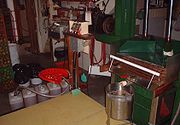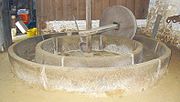
Cider mill
Encyclopedia




Apple juice
Apple juice is a fruit juice manufactured by the maceration and pressing of apples. The resulting expelled juice may be further treated by enzymatic and centrifugal clarification to remove the starch and pectin, which holds fine particulate in suspension, and then pasteurized for packaging in...
for use in making apple cider
Apple cider
Apple cider is the name used in the United States and parts of Canada for an unfiltered, unsweetened, non-alcoholic beverage made from apples...
, applejack
Applejack (beverage)
Applejack is a strong alcoholic beverage produced from apples, popular in the American colonial period.Applejack was historically made by concentrating hard cider, either by the traditional method of freeze distillation or by true evaporative distillation. The term applejack derives from jacking, a...
, hard cider, apple wine
Apple wine
Apple wine can mean:* Cider, a fermented alcoholic beverage made from apple juice** Apfelwein, a German variety of cider...
, pectin
Pectin
Pectin is a structural heteropolysaccharide contained in the primary cell walls of terrestrial plants. It was first isolated and described in 1825 by Henri Braconnot...
and other products derived from apple
Apple
The apple is the pomaceous fruit of the apple tree, species Malus domestica in the rose family . It is one of the most widely cultivated tree fruits, and the most widely known of the many members of genus Malus that are used by humans. Apple grow on small, deciduous trees that blossom in the spring...
s. The mills used to manufacture the juice products, ferment
Fermentation (food)
Fermentation in food processing typically is the conversion of carbohydrates to alcohols and carbon dioxide or organic acids using yeasts, bacteria, or a combination thereof, under anaerobic conditions. Fermentation in simple terms is the chemical conversion of sugars into ethanol...
them, store them and ship them, are usually located near apple orchard
Orchard
An orchard is an intentional planting of trees or shrubs that is maintained for food production. Orchards comprise fruit or nut-producing trees which are grown for commercial production. Orchards are also sometimes a feature of large gardens, where they serve an aesthetic as well as a productive...
s. Historically, the types of structure and machinery have varied greatly—including horse powered, water driven, and machine operated mills. The presses can be fixed or portable.
Types of operation
Some mills allow custom pressing of a farmer's apples. In this way, apple varieties can be blended to make a cider of mixed juice types, for instance, a combination of sweet and aromatic juices. Various types of apple are recommended for cidering. (page 103) Alcoholic cider can also be produced and is known as hard cider or applejackApplejack (beverage)
Applejack is a strong alcoholic beverage produced from apples, popular in the American colonial period.Applejack was historically made by concentrating hard cider, either by the traditional method of freeze distillation or by true evaporative distillation. The term applejack derives from jacking, a...
. Cider is stored and fermented in wooden barrels, carboy
Carboy
A carboy is a rigid container with a typical capacity of 5 to 15 gallons . Carboys are primarily used for transporting fluids, often water or chemicals.They are also used for in-home fermentation of beverages, often wine.-Brewing:...
s, and glass jugs.(page 165)
New England cider mills
In 19th Century New England, apple farmers paid a mill owner a fee to crush apples into juice. A typical cider mill would look like many other small barns and sheds, with a set of large doors in the center of the longer side. Most cider mills were 20-30' long by 20-25' in width.The equipment in a cider mill consisted of the nut mill or crusher, and the press. The working parts of the nut mill were two wood cylinders (the nuts), one with teeth and the other with corresponding slots. The nuts were set vertically into a frame with feed and collecting troughs. One nut had a large drive shaft, extending above the frame, which was attached to a sweep eight to eleven feet long. A horse, harnessed to the long sweep, would turn the cylinders which meshed together and ground the apples to a pulp. This pulp, or pumace, was usually left in the trough over night to mellow before being transferred to the press, at the opposite side of the building. The crushed apples were piled in layers with straw in between on the base of the press. This pile, called a cheese, would then be squeezed by the pressure created by lowering screws with levers, and the filtered juice would flow into barrels.
Nathaniel Hawthorne
Nathaniel Hawthorne
Nathaniel Hawthorne was an American novelist and short story writer.Nathaniel Hawthorne was born in 1804 in the city of Salem, Massachusetts to Nathaniel Hathorne and the former Elizabeth Clarke Manning. His ancestors include John Hathorne, a judge during the Salem Witch Trials...
described New England cider mills as operated by a "circumgyratory horse." At Old Sturbridge Village in Massachusetts, 19th Century cider mill equipment is still used to make cider.
Legal issues
Cider mills have been subject to legal proceedings over whether they were "fixed to freeholdCustomary freehold
Customary freehold is in English law a species of tenure which may be described as a variety of copyhold. It is also termed privileged copyhold or copyhold of frank tenure. It is a tenure by copy of court roll, but not expressed to be at the will of the lord. It is, in fact, only a superior kind of...
s" and other cases addressing legal designation as to what kind property a cider mill is.
Further reading
- Benjamin Albert Botkin http://books.google.com/books?id=SB4KAQAAIAAJ&q=cider+mill&dq=cider+mill&lr= A treasury of New England folklore: stories, ballads, and traditions of the Yankee people Crown Publishers, 1947 934 pages

